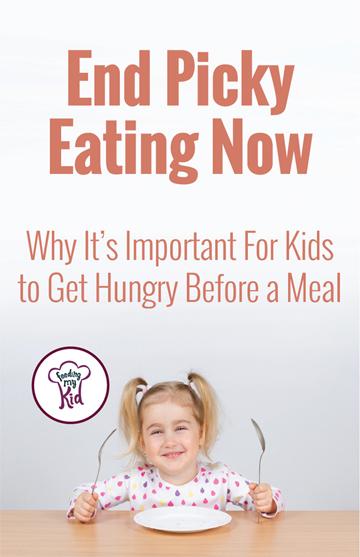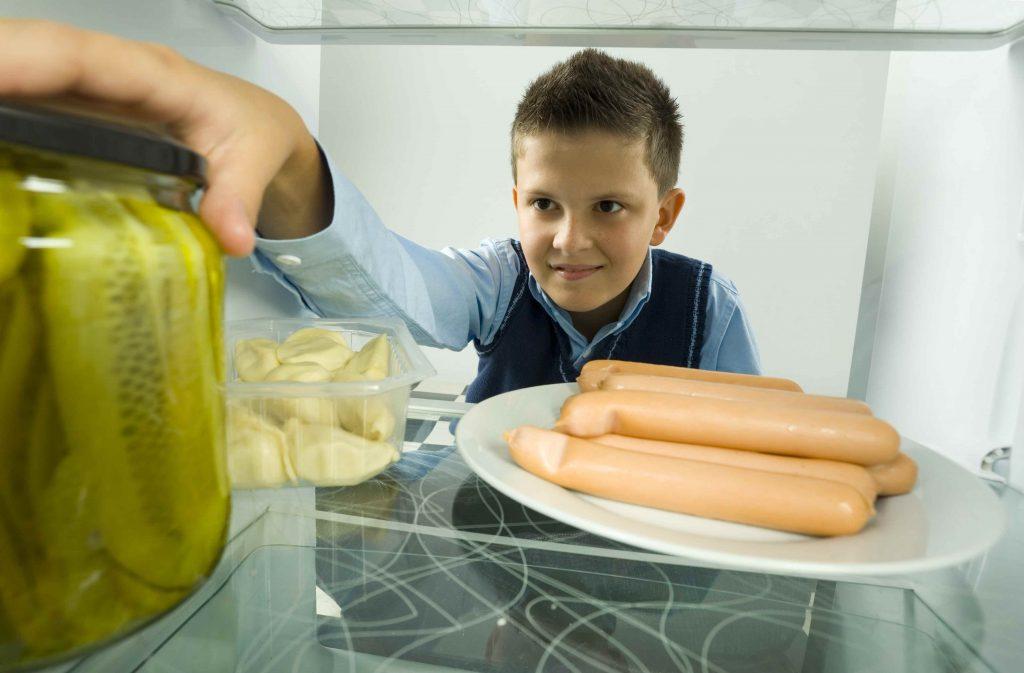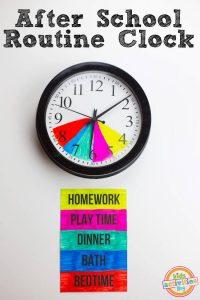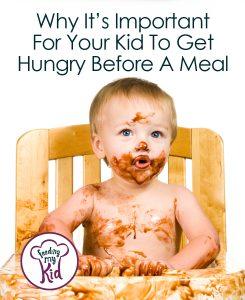 It is important your kids learn not to fear hunger. I am definitely not talking about neglecting or starving your child. I am talking about the natural hungry we all feel before a meal. We want our children to feel this hungry and it’s the healthiest thing for them!
It is important your kids learn not to fear hunger. I am definitely not talking about neglecting or starving your child. I am talking about the natural hungry we all feel before a meal. We want our children to feel this hungry and it’s the healthiest thing for them!
It wasn’t until I wrote this article that I realized, I have never let myself get hungry. I had a mother that always stuffed food in my mouth, out of love of course. She was from the old country and her way of showing love was through food. It took me writing this article to become aware and present to the notion that I was a grazer. It’s amazing how we are not always aware of our own relationship with food.
Now, let’s talk about the importance of feeling hungry.
The Upside of Hunger
If a child is not given the chance to feel hungry, then he or she may not learn how to connect feeling hungry with eating. We do not always eat because we are hungry, sometimes we eat because we are bored, unhappy, lonely, etc. We want children to learn to associate food with hungry and to try to avoid eating when bored or unhappy, which can cause weight gain and chronic diseases like Type-2 Diabetes, heart disease, etc.
The first few years of a child’s life are all about learning what their body can do. Feeling hungry and feeling full after a meal, is a big part of this learning curve. During this phase, kids will also learn how to read their body cues for when they need to go potty. It is important your child learn to not fear being hungry. Otherwise, a child can possibly develop an unhealthy relationship with food.
It Is Important That Kids Learn Not To Be Afraid Of Feeling Hungry
If kids are hungrier when they sit down for mealtime, they are more open to trying new foods!
In our home, dinner time is the best time to introduce new foods. That’s generally when they are most hungry and have their guard down about trying new foods.
 In order for our bodies to tell us we are full, it’s best to go from a hungry state to a full state. If you begin to eat from
In order for our bodies to tell us we are full, it’s best to go from a hungry state to a full state. If you begin to eat from
If you have some food in your belly and you begin to eat, then your body probably won’t tell you that you are full until you are too full.
Let me explain: Think of it as a staircase, if you start on the 4th stair then you won’t walk up a full flight of stairs until you are on the 4th stair of the following floor, but now you’ve crossed from being full to being too full.
Our stomach and brain are not smart enough to tell us when we are actually full, it tells us we had a change of state, which is why it is important to start eating when you are hungry.
Teaching Kids the Difference Between Emotional and Physical Hunger
You want your kids to learn the difference between emotional and physical hunger. We all know the emotional type of hunger. When we feel blue, many of us will eat some chips, ice cream or some chocolate thinking that we are hungry, when we are actually emotionally hungry. We want our kids to learn the difference of physical hunger and emotional hunger.
Is your child hungry or thirsty? When we start to get dehydrated, our bodies are trying to tell us, but often we misinterpret it as hunger when it’s thirst.
Many parents worry their kids do not eat enough, so they don’t let them get hungry. But, you might not know that it actually makes the problem worse. You might be a hunger avoider and allow your kids to snack often. Kids figure this out quickly and start to exploit it.
Managing Your Child’s Hunger

One of the first steps to getting started is ensuring you have a strict mealtime schedule for your child. There should be three mealtimes scheduled, morning, afternoon and evening. Most families have 1-2 snack times in between or they allow their child to snack on-demand.
If kids are on an eating schedule, then they should be getting a good size meal at mealtime and then a snack at snack time. This allows kids a chance to get hungry in between meals while keeping hunger meltdowns at bay.
Teaching Natural Consequences
It’s also important to teach your kids natural consequences. If they don’t eat their meal at mealtime, then they won’t get another snack until snack time. If they get hungry between mealtime and snack time, then that is a natural consequence of not eating a good meal at mealtime.
If a child doesn’t get a chance to experience the natural consequences of feeling hungry, then what is the motivation to eat his or her meal at mealtime?
 If a child knows he will be able to eat a snack that is probably yummier than what you was served at lunch or dinner, then why would he eat the meal in the first place?
If a child knows he will be able to eat a snack that is probably yummier than what you was served at lunch or dinner, then why would he eat the meal in the first place?
Don’t Undermine Your Efforts
Think of all those PB&J sandwiches that were given after an unsuccessful meal. This can send the wrong message to a child that you do not need to eat your meal because you’ll just get what you want later on.
Here is a suggested schedule, but obviously every family is different and has different obligations at different times of the day.
Suggested Mealtime/ Snack Time Schedule:
7 am Wake up, have some water
7:20 am Eat breakfast, have milk after meal
9 am Have a healthy snack, offer water or maybe a few oz of milk, water preferably so child doesn’t get full for lunch
11 – 12 Eat lunch, offer water during meal and offer milk right after meal
3:30-4 Snack with water
5-6 pm Eat dinner, offer water during meal and offer milk right after meal
For milk, try to not give your child more than 16 oz of milk in a day. If your child ate a lot of cheese or other dairy, pull back on how much milk you give your child and have them make up their fluids with water.
How to Start?
There is no better time to start than now.
Make sure you have healthy snack options available when you start the new mealtime schedule.
If your kids are snacking on-demand, then they are not getting hungry so they are less interested in eating a meal at mealtime. They are just content enough in their bellies that they want to do anything and everything- but eat.

If this sounds like your child, you are not alone. This is the same vicious cycle happening in so many homes. After mealtime is over, your child is starving for a snack. Since you know they didn’t eat anything at mealtime, you give them a hearty snack that fills them up, and the vicious cycle continues for the next meal. Sadly, most processed snacks are filled with
This is the same vicious cycle happening in so many homes. After mealtime is over, your child is starving for a snack.
Since you know they didn’t eat anything at mealtime, you give them a hearty snack that fills them up, and the vicious cycle continues for the next meal. Sadly, most processed snacks are filled with empty calories.
It’s important to break this cycle. It’s also important to understand there are better snacks to give your kids that will help them have a more successful meal at mealtime. If your child is over the age of 3-4 then you may want to consider cutting out snacks altogether.
If your child is eating protein, fiber, and fat at their meals, they should be able to last until the next meal. If your child is filling up on simple carbohydrate then your child will get hungry about 1.5 hours later and will be demanding a snack.
Try to give your child meals and snacks that have complex carbohydrates, proteins, fats, and fiber.
Try Moving Up Dinner to An Earlier Time For Younger Kids
Also, try moving up your dinner times, if you can. Generally, younger children need to eat around 5 pm, which doesn’t work for most working families. If there is a way to feed your tot a healthy dinner earlier in the evening, then they are more likely to eat a full meal.
Some young children are too tired to eat a dinner if it’s too late in the evening. A lot of effort and energy goes into eating and their little bodies are tired. Your child can have an after dinner snack when the rest of the family sits down for dinner.
It’s Not Easy
Changing your child’s eating habits is going to be hard. There are no short cuts.
Getting children to do something different is challenging and they definitely don’t make it any easier.
Think of this like potty training. You are trying to get your child to recognize his body cues for when he has to go and then to hold it and go when appropriate. It’s an uphill battle and so is creating healthy mealtime habits.
It’s worth the fight, I promise!
Share your thoughts
How comfortable are you at letting your child get hungry? Do you agree? Do you disagree? Share your thoughts.
Check Out More Kids Recipes Here:
- Cooking with Kids: Creative Ideas to Get Your Kids in the Kitchen
- How to Teach Your Kids Healthy Eating Habits (Without Losing Your Mind)
- The Best Creative Crafts to Keep Your Kids Entertained

